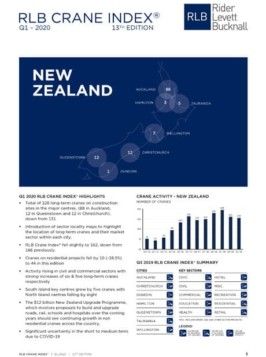Nearly all of New Zealand’s 128 long-term cranes have stopped working as construction sites were shut down across the country as part of the Government stage 4 response to COVID-19.
The only cranes still operating are on those working projects deemed as essential.
According to the Q1 2020 RLB Crane Index® released today, there are currently 128 long term cranes sighted across the country (88 in Auckland, 12 in Queenstown, 12 in Christchurch, 7 in both Wellington, 5 in Tauranga, 3 in Hamilton and 1 in Dunedin), equating to a net decrease of only 3 cranes from the previous edition six months ago.
RLB Director Mr Chris Haines said, ‘With the country in lock-down due to COVID-19, nearly all live projects have been suspended for a minimum period of 4 weeks.’
Essential health projects continue
‘We are only aware of a handful of health projects in Auckland and Christchurch for DHB’s and Southern Cross that have applied to be deemed “essential” and can continue construction during lockdown,’ he added.
All infrastructure work including Auckland’s City Rail Link, Watercare’s Central Interceptor and major roading projects such as Puhoi to Warkworth expressway, Kaipiti expressway and Transmission Gulley have stopped. All residential and commercial projects work has now stopped. Whilst design and tendering continue working from home, the live construction work cannot progress.
Risks affecting current live projects
According to RLB’s Chris Haines, following the lockdown there are several key risks to current live construction projects including:
- The limited cashflow that will test the financial solvency of main contractors, sub-contractors, suppliers and some developers will also be under pressure. The government subsidies and assistance packages, and the dispensations given by the banks will be key to ensuring projects and parties can viably continue during and after the lockdown
- Potential contractual disputes on the right to time extensions and the extent of any cost recovery is likely as contracts, legal advice and approach taken vary from project to project
- Security of sites, particularly where any site security personnel is not considered an essential service means the risk of theft and potential recovery of materials and equipment could be high
- Protection of work in progress. Contractors have had a very limited time to get organised. Risk of exposed timber or finishes to the weather and potential future abortive work and replacement will be high in some projects depending on the stage they are currently at
- Health & safety of the sites. Ensuring they have been left safe to avoid members of the public from accessing sites or tower cranes during the lockdown
Residential cranes record highest fall since 2016
The 13th edition (Q1 2020) of the RLB Crane lndex® fell 11 per cent from the record high seen twelve months ago. Although construction demand in Auckland remains strong, there are signs of an easing in capacity pressures in the Auckland construction sector and a lowering of its share of the total New Zealand market.
This is reflected in the total crane numbers across New Zealand where Auckland’s share of total cranes has fallen from a high of 72.5% in the last edition to the current 68.8%.
Cranes across Auckland fell by 7%. The Q1 2020 index fell from 288 to 267, a net fall of 7 cranes. The net decrease of seven cranes across Auckland was a result of 27 new long term cranes being added to new projects and 34 removals, bringing the regions current total to 88 cranes.
Across New Zealand, the share of residential cranes has fallen to 34%, the lowest number since our Q2 2016 report. This reflects completion of many apartment projects and the growth being seen in the non-residential sectors over the past year.
Wellington shows positive movement due to commercial projects
In Wellington, this largely reflects increased crane numbers in commercial projects.
Meanwhile, growth in Auckland was driven by a stronger spend in infrastructure projects and demand for office and hotel buildings. Auckland contributed to almost all of the net fall of cranes across the country with seven, with the South Island centres of Christchurch and Queenstown showing strong combined gains of 5 cranes.
Across the North Island, Wellington was the only region with a positive movement in long term crane numbers (+1). Both the civil and commercial sectors saw strong gains across the country offset by residential cranes falling by double digits.
Pipeline of future work in doubt
The impact of COVID means the pipeline of forward work across the country is expected to change fairly significantly, trending downwards, especially in the tourism, retail, commercial and aged-care sectors. The hope is government will push through more hospitals, schools and infrastructure projects to support the construction sector.
FURTHER INFORMATION:



